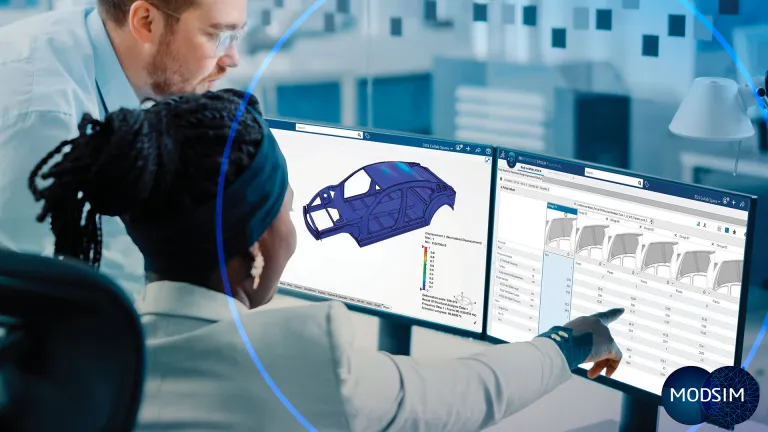Simulation Software for Engineering Analysis & Optimization
Revolutionizing the way industries work by allowing users to model real-world phenomena, optimize processes and make informed decisions without costly physical testing.
What is Simulation Software?
Simulation software is a powerful tool that uses mathematical models to replicate real-world processes, systems, or phenomena in a virtual environment. It enables users to analyze, predict and optimize complex scenarios without the need for physical prototypes or real-world testing.
Key Benefits of Simulation Software
Simulation Software & Sustainability
Driving Eco-Friendly Innovations
Simulation software is essential for advancing sustainable practices by enabling virtual prototyping, reducing the need for physical resources, while also optimizing designs for energy efficiency.
It's instrumental in improving renewable energy systems and enhancing carbon capture and storage technologies for greater efficiency and safety. What’s more, it helps urban planners and manufacturers design smart cities and circular economy models to minimize waste and maximize resource use.
3D Simulation Software across Industries
Discover how 3D simulation software is transforming key industries by enabling virtual testing, optimizing performance and driving innovation.
Driving Innovation with Dassault Systèmes’ Simulation Solutions
Dassault Systèmes empowers industries with advanced simulation solutions through the 3DEXPERIENCE platform. The SIMULIA portfolio offers multi-physics simulation, including structural analysis, fluid dynamics and electromagnetics, driving innovation and optimizing performance while enhancing understanding of product behavior to reduce risks and improve design accuracy.
Advanced Structural Simulation
SIMULIA's Finite Element Method (FEM) technology creates detailed virtual prototypes to assess product performance under real-world conditions. Evaluate crucial indicators like stiffness and strength to ensure safety, durability and compliance with industry standards across sectors.
Electromagnetic Simulation Software
SIMULIA's electromagnetic software efficiently tackles multiscale challenges throughout the design process. Specialized solvers deliver fast, reliable results from concept to performance analysis, revolutionizing how engineers approach electromagnetic system design.
High-Fidelity CFD Simulation
PowerFLOW and XFlow technologies deliver precise fluid performance predictions across industries. SIMULIA's Computational Fluid Dynamics (CFD) enhances product development from automotive fuel efficiency to race-car aerodynamics with accurate, rapid simulations.
Multibody Dynamics Analysis
SIMULIA provides a comprehensive analysis of mechanical and mechatronics systems. Engineering teams gain deep insights into complex interactions and movements, enhancing the design and functionality of vehicles, turbines and engines.
Vibro-Acoustics Simulation
SIMULIA excels in noise and vibration analysis with deterministic and statistical methods optimized for each design stage. Enhance sound performance from early phases, reducing late-stage modifications and costs while improving user satisfaction.
Design Automation & Optimization
SIMULIA streamlines workflows through powerful automation and optimization capabilities. Maximize performance efficiently, ensure designs meet specifications and enable innovative solutions across industries with advanced simulation technology.
Customers' Experience with Our Simulation Solutions
Dassault Systèmes' simulation software has allowed numerous companies across various industries to achieve remarkable results.
MODSIM Unified Modeling & Simulation
Step into the future of engineering with MODSIM, where modeling and simulation converge on the 3DEXPERIENCE® platform! This innovative cyclical process automatically updates simulations with design changes, streamlining geometry cleanup and meshing. Embrace automated parametric studies for dynamic design exploration, all while fostering collaboration across program, product and test management. Transform your engineering processes for unmatched efficiency!
AI and Machine Learning in Simulation
To fully leverage simulation capabilities, SIMULIA offers machine learning neural network models that can be trained on design and simulation data to replicate system behavior. This technology accelerates the modeling and optimization of future designs, allowing users to explore design variations quickly and efficiently. With AI-powered design optimization, teams can focus on what truly matters in their projects.
Use Cases: Key Business Functions of Simulation Tools
Unlock the full potential of engineering and product development with simulation software—improve accuracy, optimize performance and cut costs before a single prototype is built.
Product Design & Testing
Finite Element Analysis (FEA) predicts structural integrity, stress and failure points, for durable results. Thermal analysis optimizes heat dissipation to prevent overheating and improve cooling. When used together, these simulations help engineers refine designs before physical prototyping.
Fluid Dynamics & HVAC Optimization
Computational Fluid Dynamics (CFD) models airflow, pressure and turbulence to improve aerodynamics and energy efficiency. Simulations optimize ventilation and climate control in HVAC engineering while ensuring regulatory compliance. These tools improve system performance and sustainability.
Electromagnetic & Electronic Simulation
Electromagnetic analysis improves the performance of antennas, sensors and motors by reducing interference and optimizing efficiency. Electronic circuit simulations refine signal integrity and power distribution, ensuring industry-standard compliance.
Generative Design & Multiphysics
Generative design uses AI to create lightweight, high-performance structures by optimizing material usage and manufacturability. Multiphysics simulation integrates structural, thermal, fluid and electromagnetic analyses for a complete view of product behavior under real-world conditions.
Manufacturing Process Simulation
Process simulations for injection molding, casting and additive manufacturing predict material behavior, which in turn reduces defects and waste. Digital twins allow for real-time monitoring and optimization of production workflows to improve quality control and minimize downtime.
Simulation Engineering Software in Education
Dassault Systèmes' SIMULIA academic program provides students and educators with advanced simulation tools for hands-on experience. It bridges the gap between academic learning and industry needs and prepares students for careers in engineering.
Dassault Systèmes provides resources and support to integrate simulation software into academic curricula. This boosts innovation and equips future professionals with essential problem-solving skills.
Dassault Systèmes Key Values in Simulation
Want to Go Further?
Explore the content below and a lot more on the SIMULIA Resource Center to learn about Dassault Systèmes and Simulation.
Get in Touch with Our Experts
If you have any questions or want to discuss your needs, just complete the form and a Dassault Systèmes expert will get in touch.
Let’s transform your operation together—contact us today!
Simulation Software for Engineering
One example of a powerful simulation program is SIMULIA by Dassault Systèmes, which includes tools like Abaqus for Finite Element Analysis (FEA), XFlow for Computational Fluid Dynamics (CFD) and CST Studio Suite for electromagnetic simulations. These tools help engineers across various industries analyze structural integrity, airflow, thermal behavior and electromagnetic fields.
Engineering simulation software can model a wide range of physical phenomena, including:
- Structural Mechanics (FEA) – Simulates stress, strain, deformation and failure in materials and structures.
- Fluid Dynamics (CFD) – Analyzes airflow, turbulence, pressure and heat transfer in liquids and gases.
- Thermal Analysis – Models heat conduction, convection, radiation and thermal expansion.
- Electromagnetics – Studies electromagnetic fields in applications such as antennas, motors and circuit boards.
- Multiphysics Simulations – Combines multiple physics domains (e.g., thermal-fluid-structural interactions) to provide a comprehensive view of product behavior.
- Acoustics & Vibrations – Simulates sound propagation, noise reduction and vibrational effects in mechanical systems.
- Optics & Photonics – Models light propagation, lens performance and optical sensor behavior.
Modern simulation software integrates seamlessly with CAD (Computer-Aided Design) and PLM (Product Lifecycle Management) tools to streamline workflows and improve collaboration.
- CAD Integration: Simulation software can import 3D CAD models directly, allowing engineers to run analyses without redrawing designs. Some platforms, like SOLIDWORKS Simulation , offer built-in FEA tools within the CAD environment, enabling real-time testing during the design phase.
- PLM Integration: PLM systems, such as ENOVIA solution. It ensures version control, tracks design iterations and facilitates collaboration among engineering teams.
- Cloud-Based Simulation: Platforms like the 3DEXPERIENCE Platform allow engineers to run simulations remotely, access shared data and make real-time adjustments, improving efficiency and scalability.
The accuracy of simulation results depends on the quality of data input, model complexity and software capabilities. When correctly validated and calibrated, modern simulation software can achieve high levels of accuracy, often within a few percentage points of real-world outcomes.
Yes, many simulation software solutions can be integrated with other business systems such as Computer-Aided Design (CAD), Product Lifecycle Management (PLM) and Enterprise resource planning (ERP). This integration enables seamless data flow and collaboration across different departments, enhancing overall efficiency and decision-making processes.
Effective use of simulation software typically requires a combination of domain expertise, mathematical modeling skills and software proficiency. Knowledge of the specific field being simulated, understanding of numerical methods and familiarity with the chosen simulation tool are essential for producing meaningful results.
Simulation software can significantly improve ROI by reducing development time, minimizing physical prototyping costs and optimizing processes. It allows companies to identify and resolve issues early in the development cycle, leading to faster time-to-market and improved product quality, resulting in substantial cost savings and increased revenue.
Circuit simulation software lets engineers test electronic circuits virtually before building them physically. These tools model the behavior of electronic components like resistors, transistors and integrated circuits through mathematical calculations.
Key features include schematic design interfaces, component libraries, multiple analysis types and performance visualization through graphs. By identifying design flaws early and optimizing performance virtually, these tools save time and money during development.













